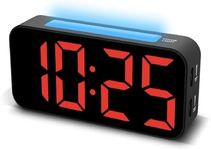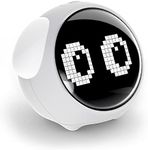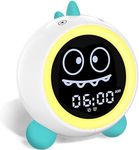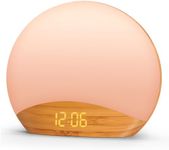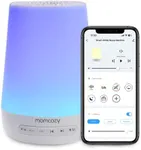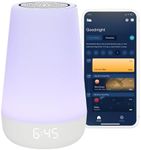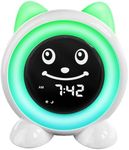Buying Guide for the Best Kids Alarm Clocks
Choosing a kids' alarm clock is about more than just waking them up in the morning. The right alarm clock can help children learn time management, develop healthy sleep habits, and even make mornings more fun. When shopping for a kids' alarm clock, it's important to consider features that match your child's age, personality, and needs. Think about what will motivate your child to get up, how easy the clock is to use, and whether it offers any educational or comforting features.Display TypeThe display type refers to how the time is shown on the clock, such as digital or analog. This is important because younger children who are still learning to tell time may find digital displays easier to read, while older kids might benefit from analog clocks to practice their time-telling skills. Digital displays are usually clear and can sometimes include large, bright numbers, which are great for early readers or for use in dim rooms. Analog clocks, on the other hand, can help reinforce learning about hours and minutes. Choose a display type that matches your child's age and learning stage.
Alarm Sound OptionsAlarm sound options refer to the types of sounds the clock can make to wake your child. This is important because some children are sensitive to loud or harsh noises, while others may need a stronger sound to wake up. Some clocks offer gentle melodies, nature sounds, or even customizable alarms, while others stick to traditional beeps or buzzers. If your child is a light sleeper, a soft sound may be enough, but for heavy sleepers, look for clocks with louder or escalating alarms. Consider your child's preferences and sensitivity to sound when choosing.
Night Light FeatureA night light feature means the clock can emit a soft glow during the night. This is important for children who may be afraid of the dark or need a little light to feel comfortable. Night lights can range from simple white lights to colorful, adjustable glows. Some clocks allow you to change the brightness or color, which can be soothing or fun for kids. If your child likes having a light at night, look for a clock with a gentle, adjustable night light. If they prefer a dark room, you might want a clock where the light can be turned off completely.
Sleep Training FunctionsSleep training functions are special features designed to help children understand when it's time to sleep and when it's okay to get up. This is important for younger kids who may wake up too early or have trouble staying in bed. Some clocks use colors, lights, or images to signal when it's time to sleep or wake up. For example, the clock might glow red at night and turn green in the morning. If your child struggles with staying in bed or waking up too early, a clock with sleep training features can be a helpful tool.
Ease of UseEase of use refers to how simple it is for both you and your child to set and operate the clock. This is important because complicated controls can be frustrating, especially for young children. Look for clocks with clearly labeled buttons, simple instructions, and intuitive settings. If your child will be using the clock independently, make sure they can easily set the alarm, turn it off, and adjust any features. The right level of simplicity depends on your child's age and comfort with gadgets.
Durability and SafetyDurability and safety refer to how well the clock can withstand drops or rough handling, and whether it is made from child-safe materials. This is important because kids can be tough on their belongings, and you want a clock that will last. Look for clocks made from sturdy, non-toxic materials with no small parts that could be a choking hazard. If your child is very young or tends to play with their clock, prioritize models that are built to handle a bit of rough use.

